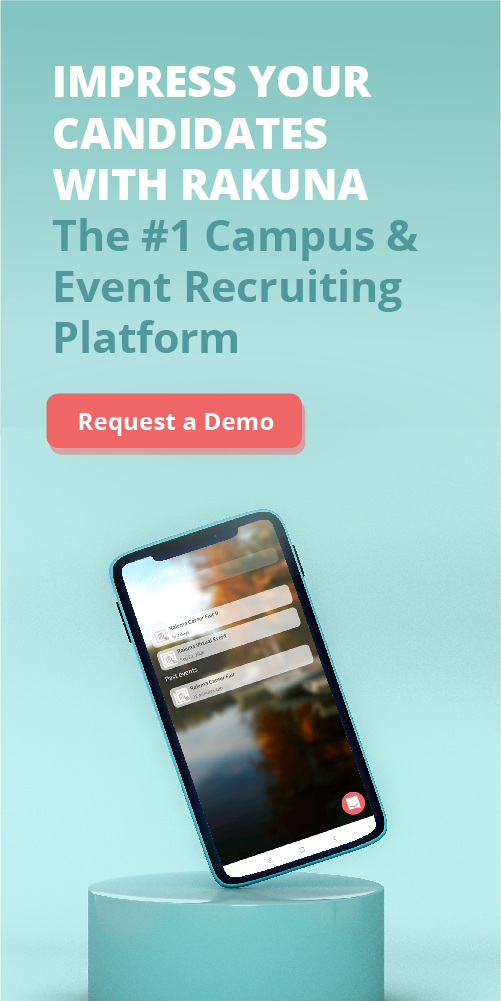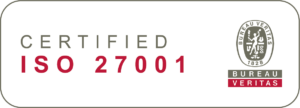Even before their final semester begins, many students are already proactively searching for post-graduation opportunities. A recent Handshake survey confirms this trend, with 30% of nearly 2,700 soon-to-graduate students already having secured a job. Spring career fairs offer a unique opportunity to connect with these driven individuals and other motivated candidates. This post provides actionable strategies to engage these new grads and internship seekers.
Get in the Momentum of Graduation Time

For graduating students, spring career fairs often coincide with their final semester. This timing creates a heightened sense of urgency as graduation approaches, and students become highly motivated to secure post-graduation opportunities. They’re not just casually exploring options—they’re actively seeking roles that align with their career goals and are ready to have meaningful conversations with employers.
Employers can harness this energy by crafting a targeted pitch that emphasizes the readiness of their opportunities. For instance, highlight any structured onboarding programs designed for new graduates, such as rotational programs or entry-level training tracks. These programs appeal to soon-to-be graduates who want a clear and supportive path into the workforce. Additionally, showcasing real-world success stories of past graduates who joined your organization and thrived can make a compelling case.
Best Practices for Employers at Spring Career Fairs
To make the most out of the graduation momentum of young talent and maximize your success at spring career fairs, consider the following strategies:
Emphasize Immediate Post-Graduation Opportunities
Showcase roles that align with the timing of the students’ transition into the workforce. Whether it’s full-time positions, internships with conversion potential, or training programs, make it clear how candidates can fit seamlessly into your organization after graduation. For instance – A tech company could offer a coding bootcamp for recent grads before officially starting their role, demonstrating investment in their professional growth.
Offer Flexible Start Dates
Not all students will be ready to start immediately after graduation. Be open to flexible start dates that account for graduation ceremonies, travel plans, or even the need for a short break after their studies. An employer could offer multi-stage onboarding sessions, with start dates ranging from June to September, ensuring students feel accommodated and valued.
Streamline the Application Process
The faster you can move candidates through the hiring process, the better. Use tools like interview scheduling software to set up on-the-spot interviews or follow-up meetings. Reduce unnecessary hurdles in your application process, such as redundant forms or lengthy wait times for feedback. Some companies bring hiring managers to career fairs to conduct immediate interviews and provide conditional offers to ensure top talent doesn’t slip through the cracks.
Summer Internship Search

Spring marks the height of internship search season, with students actively seeking opportunities to gain hands-on experience in their chosen fields. This time presents a prime opportunity for employers to engage with a dynamic and motivated talent pool eager to learn and showcase their abilities. Internships during this period can serve as a low-risk, high-reward “test drive” for future full-time hires while enabling companies to build their talent pipelines.
Beyond just filling short-term needs, internships offer multiple strategic advantages for employers. Interns who have a positive experience often become brand ambassadors for your company, sharing their journey with peers and enhancing your employer brand on campuses. Moreover, internship programs allow you to evaluate candidates in real-world scenarios, providing insights into their work ethic, adaptability, and cultural fit—qualities that can be harder to gauge in traditional interviews.
Best Practices to Attract Candidates With Internship Opportunities at Spring Career Fairs
To stand out in a competitive market and attract qualified talent, your internship program must be thoughtfully designed and effectively communicated.
Communicate a Clear Learning Objectives, Responsibilities, and Mentorship:
Students are drawn to internships that promise more than just administrative & low-level tasks. They want roles where they can learn, contribute meaningfully, and grow professionally. Clearly outline the skills and experiences they will gain, the projects they’ll work on, and the mentorship they’ll receive from seasoned professionals.
A marketing firm might emphasize that interns will learn to create and execute social media campaigns, analyze performance metrics, and receive one-on-one guidance from senior strategists.
Showcase Intern Success Stories and Career Paths
Sharing the success stories of former interns who transitioned into full-time roles within your company can be a powerful recruitment tool. Highlighting these pathways shows candidates that your organization is invested in their long-term growth and development.
Include testimonials from past interns on your career page or during career fairs. For example, a former engineering intern could share how their summer project led to a full-time role as a software developer.
Offer Competitive Internship Stipends and Perks
Compensation matters, even for internships. Offering competitive stipends or hourly wages demonstrates that you value the work interns will contribute. Perks such as access to networking events, free meals, or flexible working hours can further set your program apart.
Tech companies often provide interns with housing stipends and access to exclusive company events, such as innovation showcases or leadership panels, making their programs highly desirable.
Early Bird Gets the Worm

The old adage “the early bird gets the worm” rings especially true in campus recruitment. Companies that engage early at spring career fairs gain a significant advantage in building relationships with potential candidates and making offers before their competitors. This proactive approach not only shortens your hiring cycle but also secures top talent while they’re still exploring opportunities.
Strategies for Effective Early Engagement
Early engagement also enhances your employer brand, positioning your organization as approachable and student-focused. By making the first move, you can give students a chance to learn about your company in a less pressured environment while preventing other recruiters from poaching promising candidates. Here are a few pointers for your team to start connecting with talent:
Host a “Spring Preview Day” for Targeted Student Groups:
An exclusive pre-fair event, like a “Spring Preview Day,” offers a unique opportunity to engage with students on a deeper level. Tailor this event to specific majors or interests to showcase your company culture, opportunities, and vision in a more intimate setting. This personal touch can help you stand out in the crowded career fair environment.
For instance, a tech company might invite computer science students to a day of coding challenges, team-building exercises, and presentations by current employees. Such events not only allow for relationship-building but also offer valuable insights into the company’s work environment.
Partner with University Career Services for Pre-Fair Candidate Screening:
Collaborating with career services provides early access to resume books and candidate profiles. This allows you to identify promising candidates in advance and come prepared with a targeted strategy. Preliminary interviews or informal “meet and greets” during the fair further streamline the hiring process.
A finance firm could review resumes of top accounting students, conduct virtual interviews beforehand, and invite selected candidates to an exclusive networking lunch during the fair.
Leverage Social Media to Create Pre-Fair Buzz:
Social media is a powerful tool to connect with candidates before the fair. Use platforms like LinkedIn, Instagram, and Facebook to promote your attendance and create excitement. Targeted ad campaigns, engaging posts, and live Q&A sessions with current employees or hiring managers can spark curiosity and draw students to your booth.
A healthcare organization could post a series of “day in the life” videos featuring interns and young professionals, followed by a live Instagram session answering questions about internship opportunities and growth paths.
Senioritis Advantage (With a Caveat)

The term “senioritis” may conjure images of disengaged students, but savvy recruiters can flip this phenomenon into an advantage. As students approach the end of their academic journey, many feel uncertain about their next steps, which often manifests as a lack of motivation. Spring career fairs provide the perfect opportunity to rekindle their drive and position your company as the solution to their post-graduation anxieties.
Strategies to Harness the “Senioritis Advantage”
Many students grappling with senioritis are more introspective about their future than they let on. They’re actively weighing the value of their academic efforts and considering their next move. By addressing their concerns directly, you can position your organization as an employer that understands and supports their transition into the workforce. Here are a few actions your recruiter can start taking:
Focus Your Messaging on Career Growth and Exciting Projects:
Appeal to senior students’ aspirations by emphasizing career growth opportunities, impactful projects, and mentorship within your organization. Use specific examples to show how past hires have successfully transitioned into fulfilling roles and advanced within your company.
Your organization can share the story of a recent graduate who started as an intern, contributed to a major product launch, and now leads a development team. Highlighting these success stories demonstrates real possibilities.
Highlight Company Culture and Work-Life Balance:
Many students at this stage are searching for employers who prioritize well-being and foster a supportive environment. Showcase your company’s culture, community-building initiatives, and work-life balance perks through visuals and testimonials from current employees.
Recruiters could share a video of their organization volunteering for a local cause or enjoying a company retreat, emphasizing the importance of both professional fulfillment and personal growth.
Offer Clear Career Progression and Development Opportunities:
Senior students are likely envisioning their long-term career path, so outline clear opportunities for growth. Detail professional development programs, certifications, and leadership tracks. Use visual aids like infographics or roadmaps to illustrate potential career trajectories. A financial firm could present a step-by-step progression chart showing how entry-level analysts can advance to senior management roles, complete with timelines and milestone achievements.
Evaluating “Real-World” Project Experience

By the time they are ready for spring career fairs, many students have completed capstone projects, research papers, or other significant coursework. These experiences offer recruiters an invaluable window into a candidate’s practical skills, creativity, and ability to tackle real-world challenges.
These projects often mirror professional tasks, such as problem-solving, teamwork, and time management. Reviewing these experiences provides a clearer picture of how well candidates can translate academic learning into workplace results.
Tips for Effectively Evaluating Project Experience
Before getting your talent into an interview, recruiters can consider taking these actions to start assessing candidates for their “real-word” experience and affinity to your organization:
Ask Specific Questions About Their Projects:
Go beyond surface-level queries by delving into the specifics of their academic work. For example, ask about the methodologies they used, the challenges they faced, and how they resolved them. This approach reveals their technical proficiency and problem-solving process.
For instance – You can ask an engineering student about the tools they used for design or simulation. For business students, inquire about the financial models or market analyses they developed.
Encourage Candidates to Bring Portfolios or Presentations
A well-prepared candidate with a portfolio or presentation demonstrates both initiative and confidence. Portfolios allow you to see tangible proof of their capabilities and provide a talking point for deeper discussions.
Look for Articulation of Challenges and Solutions
Candidates who can showcase how they overcame obstacles in their projects are often the ones who can thrive in a professional setting. Listen for examples of resourcefulness, collaboration, and adaptability but also be on the lookout for potential redflags such as exaggeration.
Gauge Candidate Flexibility and Availability

Spring career fairs provide an excellent opportunity to assess candidate availability and flexibility for upcoming roles. With the holiday season behind them and academic demands relatively low, students are often in a better position to discuss their plans. Understanding a candidate’s immediate and future availability allows recruiters to align their hiring schedules with candidate preferences and ensures smoother onboarding processes.
How to Gauge Flexibility and Availability Before Spring Career Fair
Candidates at spring career fairs are often more receptive to discussions about timelines and commitments, making this a prime time to gather details. Use this opportunity to establish clarity around role expectations, including start and end dates, workload intensity, and location preferences. Early discussions about scheduling logistics can help minimize last-minute surprises, start by:
Discuss Work Arrangements and Explore Potential Fit:
Recognizing that not every candidate prefers a traditional 9-to-5 work structure is key to modern recruitment. Open conversations about alternative arrangements such as part-time internships, flexible hours, or remote work opportunities showcase your company’s adaptability. These options are especially appealing to candidates balancing multiple commitments, such as coursework, extracurricular activities, or family responsibilities.
A tech startup could offer a hybrid internship where students work remotely on weekdays and on-site during critical project milestones. Highlighting such flexibility can differentiate your organization from competitors.
Inquire About Long-Term Career Aspirations:
Beyond immediate availability, discussing a candidate’s career goals can foster stronger engagement. Asking open-ended questions about their ambitions helps position your company as a partner in their professional journey. Frame the role not just as a job but as a stepping stone to achieving their aspirations.
For example, if a candidate is interested in leadership roles, discuss mentorship opportunities or leadership training programs within your organization. Show how their contributions can lead to larger responsibilities and long-term growth.
Leverage a “Candidate Interest Form” for Deeper Insights:
Move beyond traditional application forms by introducing a “Candidate Interest Form” that captures more than just availability. Include questions about:
- Preferred work environments: Do they thrive in collaborative settings, or do they prefer independent work?
- Project interests: Are they more inclined toward research, hands-on execution, or client-facing roles?
- Desired learning outcomes: What skills or knowledge do they hope to gain from this role?
A richer dataset allows you to make more informed decisions, ensuring that candidates are matched with roles that align with their preferences and strengths. If a candidate expresses interest in developing technical skills, you could assign them to a role with opportunities for hands-on software development or data analysis, creating a more meaningful experience for both parties.
To Conclude: Reap the Rewards of Spring Recruitment
Spring career fairs are a goldmine for top-tier entry-level talent and interns. Implement these strategies for a competitive edge. If your recruiting team already has a list of recruitment events for your Spring recruitment efforts, don’t forget to bring these pocket guides on Pre-career fair outreach and Post-career fair communication to bring in qualified talent without breaking a sweat. Happy Recruiting!


